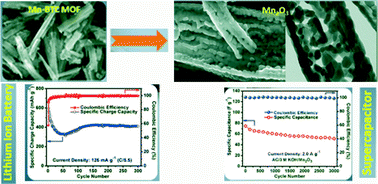Electrochemical energy storage in Mn2O3 porous nanobars derived from morphology-conserved transformation of benzenetricarboxylate-bridged metal–organic framework†
Abstract
Tailoring the morphology of mesoporous nanostructures toward performance enhancement plays a key role in developing efficient energy storage devices. Herein, we report the formation of well crystallized Mn2O3 mesoporous nanobars through simple exo-templating of a manganese 1,3,5-benzenetricarboxylate metal–organic framework (Mn-BTC MOF) by thermal treatment whereby the general morphology of the parent MOF is conserved, but with more voids and spaces. The parent Mn-BTC MOF was synthesized by solvothermal reaction of trimesic acid with manganese nitrate in alcoholic solution. The MOF-derived Mn2O3 was characterized by XRD, field-emission SEM, high-resolution TEM, and N2 adsorption/desorption isotherm measurements. When examined as an anode material for lithium-ion batteries in the potential windows of 0.01–3.0 V and 0.01–2.0 V, high reversible specific capacities of 849 and 778 mAh g−1 were obtained. It was found that the electrochemical processes are more reversible when cycled in the 2 V window. A steady capacity of ∼410 mAh g−1 was observed after 300 continuous cycles at ∼C/5.5 exhibiting good cycling stability in the 2 V window. When tested as a pseudocapacitor electrode in a three-electrode configuration, a specific capacitance of 250 F g−1 at 0.2 A g−1 could be achieved. Further, to demonstrate practical applicability, two-electrode asymmetric supercapacitor pouch cells were assembled with Mn2O3 as the positive electrode and commercial activated carbon as the negative electrode which showed an ultrahigh energy density of 147.4 W h kg−1 at a power density of 1004 W kg−1. The present work shows the potential of a MOF derived route for obtaining metal oxides with desired nano-architectures for electrochemical applications with high performance.


 Please wait while we load your content...
Please wait while we load your content...